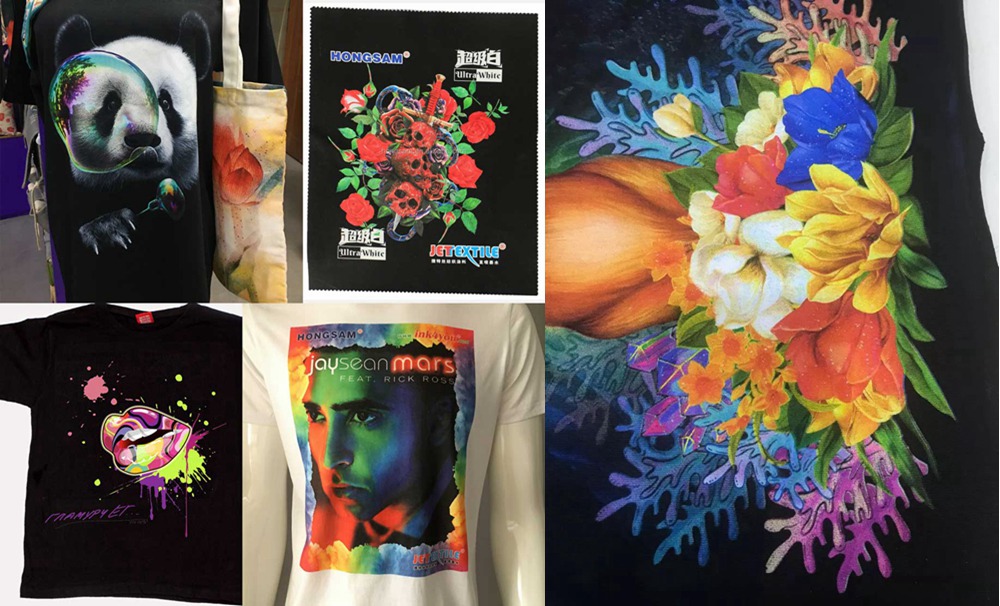Comparison of DTF Printing and DTG Printing on Color Performance, Fastness, Application and Cost
1. Color Performance
Both DTF printing and DTG printing are digital printing, with similar color richness but different printing processes.
DTG directly printing: directly print white ink on the fabric, and then print color inks on the white ink. Since white ink is directly printed on the clothing fabrics, part of the white ink will be absorbed by the fabric, and the surface of most fabric fibers is uneven, so the white ink is not so white to us. Therefore, when color inks are printed on the white ink, the color is not very bright.
DTF printing: firstly, print color inks on the transfer film, and then print
white DTG ink on the color inks. After dusting glue powder on the printed film, transfer it on the clothes in reverse.
DTF ink is directly printed on the film, which is actually printed on the coating of the film. The coating will not absorb any ink and can ensure that the ink does not spread.
White DTF ink is printed on the color inks, and then be dusted glue powder to ensure bright colors.
Conclusion: At present, it seems that the color of DTF printing is better than that of DTG directly printing.
2. Fastness
We often talk about three types of clothing fastness: dry rubbing fastness, wet rubbing fastness, and washing fastness.
Dry rubbing fastness: The dry rubbing fastness of DTF printing is generally level 4-4.5, while directly printing is generally above level 4. DTF printing is better, but they can all meet the requirements.
Wet rubbing fastness: The wet rubbing fastness of DTF printing generally reaches level 4, and directly DTG printing is generally level 3-4. DTF printing is better.
Washing fastness: The washing fastness of DTF printing usually reaches level 4, and direct DTG printing usually reaches level 3-4. DTF printing is still better.
3. Application
In principle, textile pigment ink is suitable for any clothing fabric, and pigment particles rely on adhesives to adhere to the clothing fabric, but there are differences in practical applications.
Film transfer process: Film transfer printing is suitable for almost all fabrics.
DTG directly printing process: In principle, textile pigment ink is suitable for any fabric, but the fastness of directly printing on some fabrics is not very well, such as polyester fabrics or fabrics with low cotton content. With the advancement of technology, maybe this problem will be solved in the future.
Judging from the current technology, the direct to film transfer process is suitable for more fabrics than that of
direct to garment printing.
4. Material Cost
For DTF printing, digital DTF ink has relatively low requirements for ink because it is printed on the film. The transfer film printing market is developing rapidly and the competition is fierce. Currently, the price of
DTF ink is lower than that of
DTG ink.
For DTG printing, the fabric needs to be pre-treated. The material cost of the pre-treatment is relatively high, which will be higher than that of the film.
5. Production Cost
The production cost is directly related to production efficiency, and the complexity of printing process has great affect on efficiency.
DTF printing process: film printing ➡ cutting ➡ transferring
DTG printing process: pre-treatment liquid ➡ drying (heat pressing) ➡ printing ➡ drying by air ➡ drying (heat pressing) for color fixation
DTG printing process and DTF printing process spend the same time to print the same pattern, but DTG directly printing requires two more processes than film transfer process. Therefore, DTG printing takes about twice time, and its production efficiency is twice as low.
In terms of the printing process, there is not much difference between the two processes, but DTF printing process is simple, efficient, and the corresponding labor cost is not high.
6. Environmental Protection
In the production process, both DTF textile printing and DTG directly textile printing are environmentally friendly.
7. Comfort of Finished Clothes
Look at the back of printed fabrics in the light, the printing part of DTG directly printing has even light coming through it, while the printing part of DTF direct to film printing is completely black without any light. If we blow air on the cloth with our mouth, we will find that the DTG printing part is breathable, while the DTF printing part is non breathable. For summer clothing, good breathability and comfort are essential.
Conclusion: Compared with the DTG printing process, DTF printing is simpler and lower in cost, but less comfortable. DTG printing is rising rapidly and mainly targeting the high-end clothing industry.
Hongsam Digital is professional in digital inkjet inks for 22 years.
For inks price and details, please leave us a message or directly contact: ella@ink4you.com https://wa.me/8618903829880

 Nov 08,2023
Nov 08,2023
